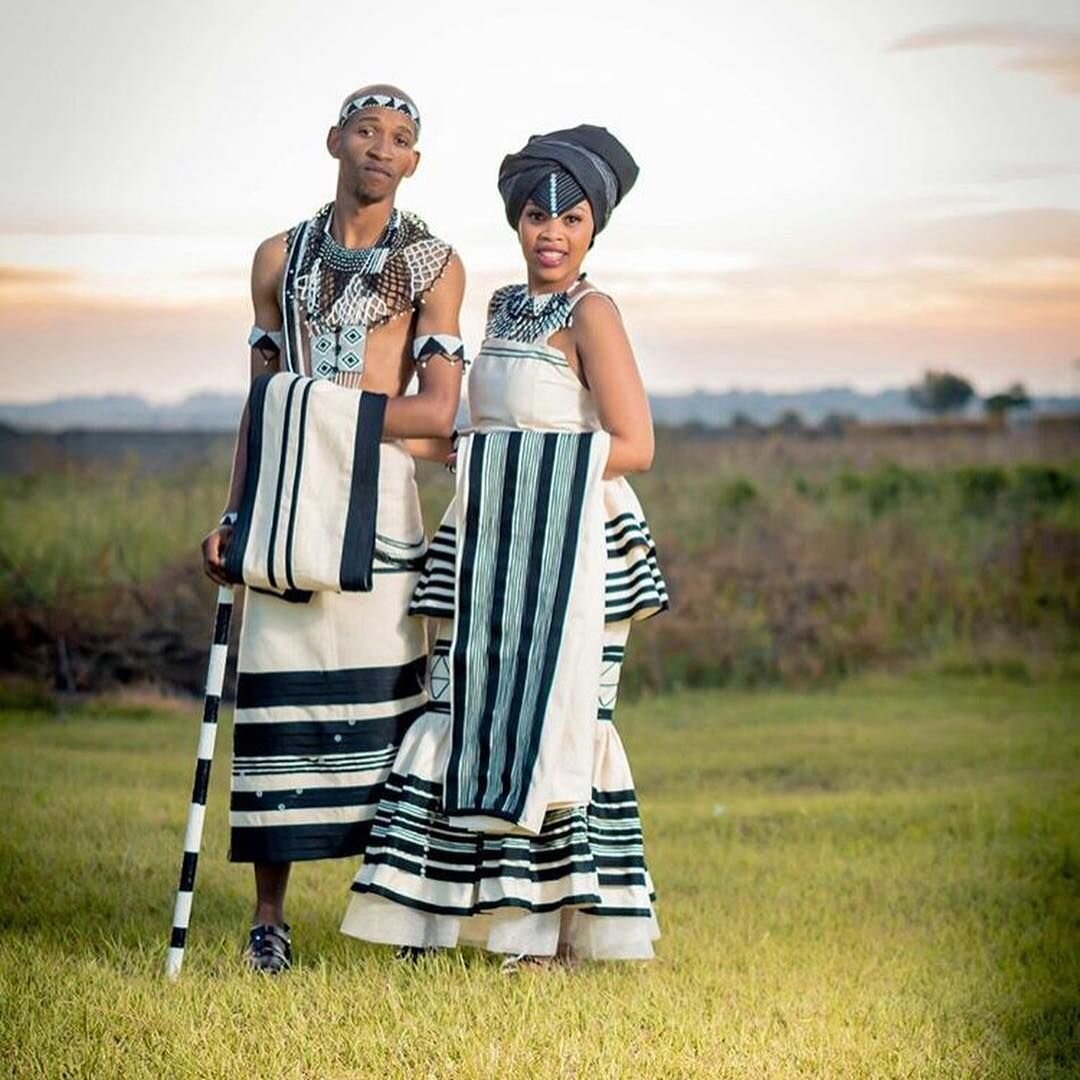Cultural Wear and Fabrics from Southern Africa
Whilst true traditional wear from southern Africa is historically animal skin based, the arrival of European and Asian influences dating back to the 16th century has led to most cultures adopting various textiles as cultural wear. From Shweshwe, to Kitenge, to Samakaka, we explore the fabrics and cultural wear from southern Africa.
Bold and vibrant Samakaka from Angola
Samakaka from Angola
Bold and colourful, this beautiful fabric comes from Angola and it goes by the name Samakaka (or Samacaca).
Although it is produced in a variety of colour combinations, the most common Samakaka print uses black, red and white - the colours of the Angolan flag.
The black represents the African continent, the red represents the bloodshed from Angola’s liberation struggle, and the yellow represents the wealth of the country. The geometric shapes on the fabric are rooted in traditional symbols.
For most people in Angola, Samakaka forms a part of everyday wear, but the fabric holds an important cultural value, central in societal occasions such as weddings, funerals and commemorative celebrations.
Indigo dyed Leteisi from Botswana
Leteise from Botswana
Botswana, like all southern African countries, is made up of a collection of many different tribes, each with their own distinctive cultural wear. However, the most widely worn cultural fabric in the country is called Leteise (or Letoitse). It is a dyed cotton fabric with intricate geometric patterns.
The most common colour used is indigo, but these days the fabric can be found in a wide variety of colours and print patterns.
The fabric used to only be worn by women, typically cut as an apron (chiba / khiba) with a matching headscarf (tukwi), but these days men also get clothes tailored using the fabric. The fabric can be seen in casual everyday settings, but it is essential for traditional gatherings such as weddings.
Basotho women from Lesotho and Xhosa women from South Africa also wear Leteise as a cultural fabric - but they call it by names such as Shweshwe and Ujamani respectively.
You often also see Batswana women wearing a checkered blanket called mogagolwane (as the women in the background in the picture are wearing). Women wear this as a societal status symbol showing they are married. Some Tswana tribes prefer wearing a more modern plain white shawl instead of the traditional mogagolwane.
A traditional family from eSwatini in traditional wear. Credit: Ludo Kuipers
Lihiya from eSwatini
In eSwatini, traditional attire is specific to gender, age and status – with strict requirements at traditional ceremonies.
In this picture, taken by Ludo Kuipers in 1971, you see a traditional Swati family. On the right, the mother of the family is dressed in the traditional top fabric called Lihiya, which she ties in an L shape hanging below her left shoulder to indicate she is married. Underneath the Lihiya, she wears Sidvwaba - a goat skin skirt. Her hair is in the traditional Sicolo beehive style of a married woman.
Her husband, on the left, wears his Lihiya around the waist, with a Lijobo animal skin over it. In his hand, he holds a Sakila - a knobkerrie stick.
The couple flank their son who simply wears an animal skin loin cloth, and their daughters, each in traditional Lihiya tied over the right-hand shoulder, with no goat skin underneath, but instead just a Sidvwashi fabric wrapped around the waist.
Basotho women wearing classic seanamarena blankets and shweshwe fabric headwraps
Seanamarena from Lesotho
Many people will probably recognise this beautiful and distinctive blanket from the recent Black Panther movie - but this is actually cultural wear from the Kingdom of Lesotho.
The blanket is called Seanamarena and was adopted by the people of Lesotho in the 19th century as a type of modernisation to the traditional animal skin cape that was worn at the time.
This new blanket was originally gifted to King Moshoeshoe I by a British trader, and due to a growing insufficiency in supply of animal skins to make the traditional Kaross, the blanket quickly gained in popularity.
Today, a variety of styles of the blanket, each with a specific name, is worn to represent the different rites of passage in society.
The maize cob is the most widely used motif on Basotho blankets, symbolising fertility and wealth. When worn in the traditional manner, the characteristic stripe on the blanket should run vertically, as a symbol of growth. Men are also supposed to wear the blanket with the darker side out, whilst women should wear it with the lighter side out.
Women in Malawi dressed in Chitenje
Chitenje from Malawi
This is probably the most widely recognised African fabric, worn particularly in east, central and west Africa.
In southern Africa, it is called Chitenje in Malawi and Chitenge in Zambia. Whilst the fabric originally comes from Indonesia, it has grown in vast popularity across Africa and is now considered cultural wear for many. The fabric is worn mostly by women, wrapped around the chest or waist, as a headscarf, and even used as a baby sling.
Chitenjes serve as an inexpensive, informal piece of clothing that is often decorated with a huge variety of colours, patterns and even political slogans. Many of the designs have a meaning or written message.
The cloth is used as material for dresses, shirts and skirts and can be used on any occasion and in many ways, either symbolically or for practical reasons. In Malawi, the fabric was never worn by men until recently when President Mutharika encouraged civil servants to buy and support Malawian products by wearing Chitenje on Fridays. Men can also be seen wearing the fabric around the waist in hot weather.
Women in Mozambique wearing their capulanas
Capulana from Mozambique
Capulanas have been worn in Mozambique since the establishment of the Arab/Indian trade routes. The fabric was received from Indian traders as a means of barter for other goods. They initially came in three colours: red, white, and black. People in Mozambique grew to embrace capulanas, preferring them over the traditional animal skins.
Early Capulana designs typically included imagery of leopards and lions. Early day styles included Ndjiti (a white and red geometric design), Xithango (plaid), and Ximangelani (ducks).
Today, these early styles of capulana are primarily worn by traditional healers, whilst more modern, colourful designs are worn by the general public as both everyday wear as well as attire for formal and cultural engagements.
Herero woman dressed in beautiful Ohorokova cultural wear. She stands with her hands up, in the classic cow horn pose © jim Naughten
Ohorokova from Namibia
Traditional wear of the Herero people of Namibia was made up of front and back leather aprons, made from sheep, goat or game skins. They were known for their ostrich shell embellished over-skirts and metal bead-work, as well as brass, copper and carved horn cuffs worn on their wrists and ankles.
With the arrival of German colonisers in the late 19th century, Herero women were initially forced to abandon their traditional wear for Victorian-era floor length gowns. This eventually gave birth to the Ohorokova, which is today considered the traditional Herero dress.
The Ohorokova is a bold, A-lined, floor-length dress with colourful, vibrant patterns worn with several petticoats underneath, creating a wide, structured dress. The dress is topped off with a beautiful cow horn shaped headdress, called Otjikaiva.
The Herero people traditionally measure their wealth in cattle and thus pay homage to that part of their identity through this beautiful traditional fashion statement. When posing for photographs, it is common for Herero women to also adopt the cow horn pose, with their arms raised and palms upwards, as the lady in the picture is doing.
Sadly, the Ohorokova is a permanent reminder of the Herero’s devastating history with their German colonisers. The genocide nearly wiped out the once prosperous people of Namibia. However, their cultural dress is celebrated and seen as an empowerment and continued protest against oppression.
Xhosa couple in traditional attire
Umbhaco from South Africa
The Xhosa people of South Africa, like other Nguni subgroups, have a complex dress code informed by a person’s age, gender and social standing, and features beautiful beading and tailored fabrics.
Some of the typical elements of a traditional married Xhosa woman include incebetha which is a long panel that is fastened over the chest and hangs over the front of the body. It is typically adorned with beads at the bottom.
Umbhaco, the name given to the traditional outfit, is the long skirt that covers the bottom half of the body, and is also adorned with beads. On the head, women wear iqhiya, a distinctive headdress. To complete the ensemble, embroidered capes or blankets called ixakatho are worn.
Men wear a skirt which is also referred to as umbhaco. Over the left shoulder, a Xhosa man will traditionally carry an adorned blanket called ingcawa. They then wear beads on their heads, around their necks, and on their arms, wrists and ankles.
Both traditional men and women can be seen with decorated and distinctive long tobacco smoking pipes. They are usually carried in a beaded bag called inxili as part of their traditional attire. Women, and especially senior women, typically have longer smoking pipes.
Shona cultural fabric - Jira reRetso
Retso from Zimbabwe
For the Shona people of Zimbabwe, traditional cloths (machira) are very often linked to spirituality and a connection to one’s ancestors.
The most well known of these fabrics is Jira reRetso. This beautiful material is typically red in colour with a distinct black and white geometric pattern. Jira reRetso is for the spirit of the hunter - a spirit that assists family members who work and bring home an income.
In Shona tradition, it has always been important to thank the hunter when they bring home their catch. The material is commonly worn by n'angas (guardians of the Shona way of life, ethics and behaviour), but unlike other spiritual materials, one does not have to be a spirit medium to own or wear Jira reRetso.
Jira reRetso can be used as ordinary clothing such as a wrap, headdress or scarf.
Visit our online store for a range of stylish, bold and colourful southern African inspired accessories, including iPhone cases, laptop cases, tote bags and backpacks. Each product is designed in celebration of the people and beautiful cultures of southern Africa - with more products to come!




















